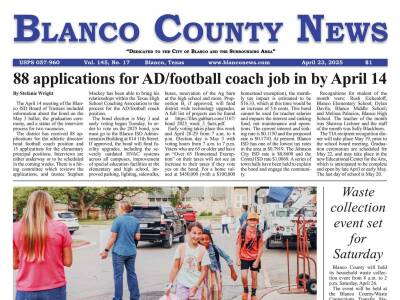Blanco County lags behind the statewide average for self-response rate for the 2020 Census.
The response rate in the county was 45.7 percent through July 12, far behind the statewide rate of 56.9 percent, according to numbers from the U.S. Census Bureau.
“I think there is a reluctance by some to give out personal information to the government. The feeling is that ‘it’s none of their business,’” said Brett Bray, Blanco County Judge. “On an individual level, I kind of share that sentiment. However, as a local official, I can see the need for Blanco County to submit all the census data that we can so that we are accurately accounted for when assistance is provided by FEMA and other agencies in times of pandemics, floods and other disasters.”
Blanco County is not only behind the statewide self-reporting rate for the Census, but also trails all but one county bordering it. Six of the seven counties surrounding Blanco County have reporting rates of more than 54 percent. Only Llano County, at 43.7 percent, has a lower self-reporting rate than Blanco County. Rates from other surrounding counties include Comal (63.7 percent), Kendall (63.4), Travis (60.9), Hays (55.4), Gillespie (54.9) and Burnet (54.6).
“Even for state grant money, oftentimes a county’s share is based on its relative size to other counties in the state,” Bray said. “If Blanco County shows a census that is below our true numbers, we get less than our fair share when opportunities arise for things like Transportation Infrastructure Funds when they become available. When we don’t get our fair share, some other county benefits and we are forced to stretch our local tax dollars (county, city, ESD, etc.) further.”
Census data is used to help determine how billions of dollars in federal funds are used, according to the Census Bureau. These uses include funds for programs such as Medicaid, Head Start, nutrition programs, programs for mental health services and many more. Data is also used to determine where new roads, schools and other services need to be built.
Census data is used to help determine voting districts at many levels. It is used by state legislatures to determine boundaries for federal and state government districts, such as a state house or senate district.
“Apportionment and re-districting depend heavily on the census,” Bray said. “While we don’t think much about it now, later, when we are scratching our head wondering why we are in this congressional district or that state house district, we probably won’t think back to the time we all needed to fill out the census so Blanco County got accurately counted.”
Census data is also used for non-governmental purposes. Businesses often use the information to determine where to expand and learn more about the communities they are already involved in, according to the Census Bureau. This data includes both population trends and growth projections.
Overall, the Census is important to the community as a whole for a variety of reasons. To complete the Census, visit www.2020census.gov, call 844-330-2020 or return the form by mail, if you have received one.
“If only six out of 10 of us here in Blanco County fill out the census, then we may only get 60 percent of the funding and representation the county deserves for the next 10 years,” Bray said “So, when taken on a macro level where all of our responses are collected to show Blanco County demographics as a whole, not for an individual, the Census is an important tool for all of our local government entities to be adequately accounted for.”



